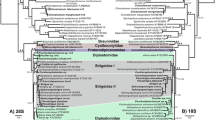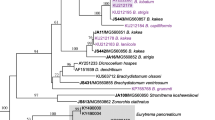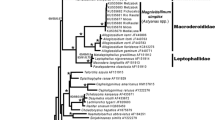Abstract
The relatively variable D1 domain near the 5′ end of the 28S ribosomal RNA gene (large subunit rRNA) has been sequenced for 12 species of digenean trematodes. Phylogenetic relationships among these species and Schistosoma mansoni (previously published sequence) were investigated with maximum parsimony and distance methods. A DNA sequence from the tapeworm (Cestoda) Hymenolepis diminuta was used for outgroup comparison. In all analyses, several clusters of taxa appeared repeatedly: (1) four fasciolids; (2) three didymozoids with a hemiurid; and (3) two lepocreadiids with a gyliauchenid. Bootstrap resampling of the data revealed that the first two clusters were well supported. In contrast there was less support for the cluster containing the lepocreadiids and gyliauchenid. We conclude that the D1 domain is too variable for phylogenetic inference among distantly related families, but it is well suited to phylogenetic inference within and among closely related families in the Digenea.
Similar content being viewed by others
References
Blair, D. & Barker, S.C. (in press) Affinities of the Gyliauchenidae: a test of the utility of the 18S rRNA gene for phylogenetic inference in the Trematoda (Platyhelminthes). International Journal for Parasitology.
Bray, R.A. & Gibson, D.I. (1991) The Acanthocolpidae (Digenea) of fishes from the north-east Atlantic: the status of Neophasis Stafford, 1904 (Digenea) and a study of North Atlantic forms. Systematic Parasitology, 19, 95–117.
Brooks, D.R. (1989) A summary of the databases pertaining to the phylogeny of major groups of platyhelminths, with a revised classification. Canadian Journal of Zoology, 67, 714–720.
Brooks, D.R., O'Grady, R.T. & Glen, D.R. (1985) Phylogenetic analysis of the Digenea (Platyhelminthes: Cercomeria) with comments on their adaptive radiation. Canadian Journal of Zoology, 63, 411–443.
Cable, R.M. (1974) Phylogeny and taxonomy of trematodes with special reference to marine species. In: Vernberg, W.B. (Ed.) Symbiosis in the sea. Columbia, SC.: Carolina Press, pp. 173–194.
Cabot, E.L. & Beckenbach, A.T. (1989) Simultaneous editing of multiple nucleic acid and protein sequences with ESEE. Computer Applications in the Biosciences, 5, 233–234.
Christen, R., Ratto, A., Baroin, A., Perasso, R., Grell, K.G. & Adoutte, A. (1991) An analysis of the origin of metazoans, using comparisons of partial sequences of the 28S RNA, reveals an early mergence of triploblasts. The EMBO Journal. 10, 499–503.
Clark, W.C. (1974) Interpretation of life history pattern in the Digenea. International Journal for Parasitology, 4, 115–123.
Felsenstein, J. (1989) PHYLIP-Phylogeny Inference Package (version 3.4). Cladistics, 5, 164–166.
Gibson, D.I. (1987) Questions in digenean systematics and evolution. Parasitology, 95, 429–460.
Gibson, D.I., & Bray, R.A. (1979) The Hemiuroidea: terminology, systematics and evolution. Bulletin of the British Museum (Natural History) Zoology series, 36, 35–146.
Gutell, R.R., Schnare, M.N. & Gray, M.W. (1990) A compilation of large subunit (23S-like) ribosomal RNA sequences presented in a secondary structure format. Nucleic Acids Research, Volume 18 Supplement, 2,319–2,330.
Higgins, D.G., Bleasby, A.J. & Fuchs, R. (1992) CLUSTAL V: improved software for multiple sequence alignment. Computer Applications in the Biological Sciences, 8, 189–191.
Lenaers, G., Scholin, C., Bhaud, Y., Saint-Hilaire, D. & Herzog, M. (1991) A molecular phylogeny of dinoflagellate protists (Pyrrhophyta) inferred from the sequence of 24S rRNA divergent domains D1 and D8. Journal of Molecular Evolution, 32, 53–63.
Pearson, J.C. (1972) A phylogeny of life cycle patterns of the Digenea. Advances in Parasitology, 10, 153–189.
Pearson, J.C. (1992) On the position of the digenean family Heronimidae: an inquiry into a cladistic classification of the Digenea. Systematic Parasitology, 21, 81–166.
Qu, L.-H., Nicoloso, M., & Bachellerie, J.-P. (1988a) Phylogenetic calibration of the 5′ terminal domain of large rRNA achieved by determining twenty eucaryotic sequences. Journal of Molecular Evolution, 28, 113–124.
Qu, L.-H., Perasso, R., Baroin, A., Brugerolle, G., Bachellerie, J.-P. & Adoutte, A. (1988b) Molecular evolution of the 5′-terminal domain of large-subunit rRNA from lower eukaryotes. A broad phylogeny covering photosynthetic and non-photosynthetic protists. BioSystems, 21, 203–208.
Sambrook, J., Fritsch, E.F. & Maniatis, T. (1989) Molecular cloning: a laboratory manual. (2nd ed.). Cold Spring Harbour, NY: Cold Spring Harbour Laboratory Press.
Swofford, D.L. (1991) PAUP: Phylogenetic Analysis Using Parsimony (version 3.0L). Computer program distributed by Illinois Natural History Survey, Champaign, Illinois, USA.
Zuker, M. (1989) Computer prediction of RNA structure. Methods in Enzymology, 180, 262–288.
Author information
Authors and Affiliations
Rights and permissions
About this article
Cite this article
Barker, S.C., Blair, D., Garrett, A.R. et al. Utility of the D1 domain of nuclear 28S rRNA for phylogenetic inference in the Digenea. Syst Parasitol 26, 181–188 (1993). https://doi.org/10.1007/BF00009725
Accepted:
Published:
Issue Date:
DOI: https://doi.org/10.1007/BF00009725




